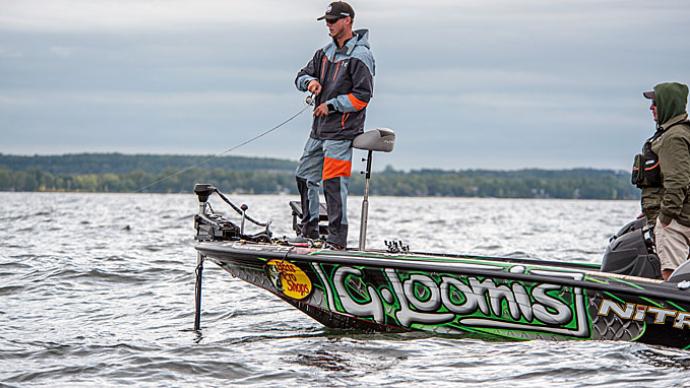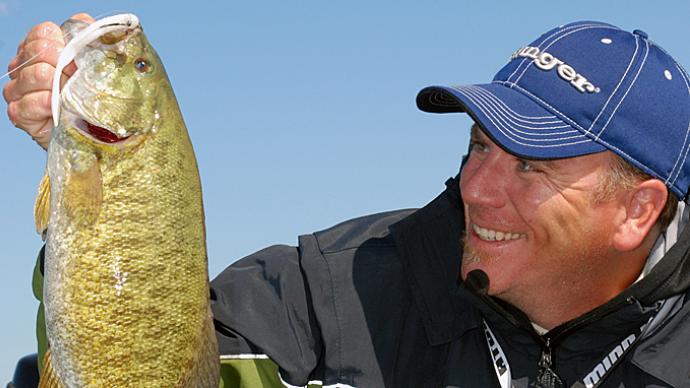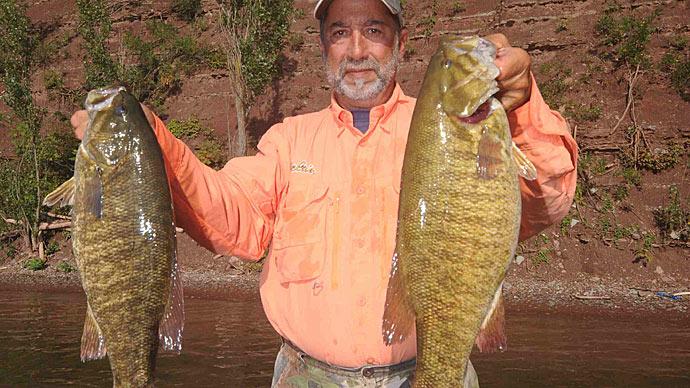
Consider yourself lucky if your home lake, river, or reservoir has aquatic vegetation. While it can be tedious to remove from your lures and lakeside homeowners and water skiers detest its existence, no other cover provides as many benefits as aquatic vegetation. The plants stabilize the bottom, improve water quality and clarity, and support a rich food chain.
Best of all, bass flock to aquatic vegetation almost year-round. “It’s one of the best covers you can get,” said Bassmaster Elite Series angler Jamie Hartman. “But how good depends on where you’re at.” Geography, time of year, and target species — largemouth or smallmouth — all play a role.
Hartman is comfortable fishing for largemouth and smallmouth any time of the year. He started the 2017 Bassmaster Elite Series season — his rookie year — with a second-place finish at Tennessee’s Lake Cherokee and ended it with a sixth-place finish at Lake St. Clair in Michigan. In between, he added three more top-12 finishes. His five are the most by any Elite Series rookie.
It’s no coincidence that Hartman started and finished so strong by catching smallmouth. He hails from New York, which offers some of the country’s best smallmouth fishing. While cutting his tournament teeth, he learned how important it was to target vegetation in fall events, when limits of bronzebacks are almost unbeatable. While most anglers equate smallmouth with hard cover, such as rock and sand, he knows they can also be caught around aquatic vegetation on many waters across their range. These include Lake Champlain, which stretches more than 100 miles between New York and Vermont, and Oneida Lake, the shallow 21-mile-long natural lake near Syracuse, N.Y., which he considers his home water.
Hartman fishes aquatic vegetation for smallmouth from post-spawn through summer, when bigger and thicker beds attract the most bass. But their preference changes when fall arrives. It’s then that he catches more smallmouth around sparse vegetation. They’re there for a reason, he said.
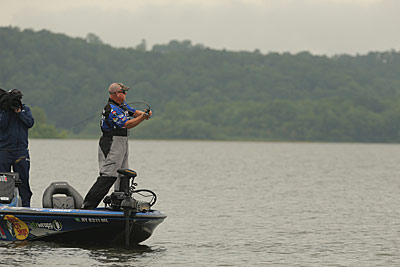
Cold-blooded creatures dominate aquatic ecosystems. Their activity increases and decreases with the water temperature. Hartman said baitfish move shallow when water temperatures begin to cool in late summer. It’s then that you’ll find them in the large beds that have held bass all summer.
But in their continuing search for comfort, baitfish begin migrating to deeper water as the water temperature drops. “That’s where the baitfish migrate to, where there is a lot of open water,” he said. And the smallmouth aren’t far behind. But before they slip into open water, he said both groups spend time in places where aquatic vegetation is broken into clumps across a hard bottom.
Hartman said the clumps provide more edges for baitfish to hold. “And that’s where the smallmouth are,” he said. And because they are moving toward open water and clean bottoms, it stands to reason that the further into fall you fish, less and less grass is needed to make a spot good. But there is an expiration date for this pattern. Once the water temperature falls, baitfish and smallmouth will completely ignore aquatic vegetation.
You don’t have to wait around for these smallmouth. They are in a chasing mood. Hartman takes advantage of their aggressiveness by fishing fast-moving lures such as swimbaits and jerkbaits. “Anything that’s a baitfish imitator,” he said. “The Alabama rig is a great way to find them when it’s available to use in the fall.”
Some tournament organizations, including the Elite Series since 2012, have banned castable umbrella rigs in competition. But that doesn’t stop other anglers from picking up a heavy rod, reel, and line and using them. The rigs imitate a small school of baitfish, especially when their arms, usually numbering three or five, are adorned with willow leaf blades and small swimbaits, usually 4 inches or shorter. Most anglers rig matching swimbaits. Try adding one that’s different in size or color from the rest. It provides bass with a target, generating more strikes.
Hartman says fishing pressure, adverse weather conditions, or plentiful crawfish may force you to slow down and fish the bottom around clumps of aquatic vegetation. He’ll throw a tube, jig, or drop shot when he faces one of those situations. But whether you fish slow or fast, make long casts. They separate you from your lure, which keeps you from spooking smallmouth in clear water. But they provide a more important benefit when chasing bass pursuing roving schools of baitfish. “They help you cover water, too,” he said.
Pay attention to your retrieve speeds. Hartman matches them to the daily fall temperature swings to get more strikes. Cold-blooded smallmouth are slowest in the mornings and evenings when temperatures are coolest. So Hartman slows his retrieve during those times. He speeds them up during the warmest parts of the days, though those get shorter as fall progresses.
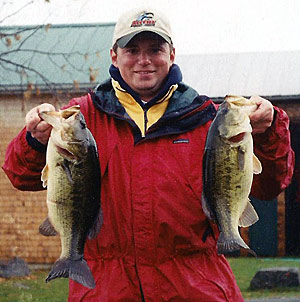
Changing your lure's depth can affect the number of strikes it draws. Hartman said some days, you’ll catch the most smallmouth by starting your retrieve as soon as your lure hits the water. On other days, you’ll have to let it sink into the water column, sometimes to the bottom. These changes are usually made in response to daily weather changes. Clouds or a wind-rippled surface, for example, will bring smallmouth and the baitfish they are chasing closer to the surface. “Keep switching until you find what they want,” he said.
You're likely to find more when you find one smallmouth around aquatic vegetation. But just because you catch a small one from the school doesn’t mean there aren’t bigger ones because most are a mix of different-sized smallmouth. Hartman offered one change you can make to improve your odds of catching bigger ones: fish slightly deeper. It’s there that aquatic vegetation will stay green the longest. “You don’t get a lot of fish from the dead stuff,” he said.
While Hartman bookended his record rookie Elite Series season with big bags of smallmouth, he also knows a thing or two about largemouth. He caught enough of them at the 2017 Elite Series stop on Toledo Bend Reservoir, which straddles the Louisiana and Texas line, to finish third. And that includes how they relate to aquatic vegetation in the fall. “They get stacked up, and they get hungry, too,” he said.
Largemouth prefer to hunker down in a spot for as long as possible. On the other hand, smallmouth spend their time cruising, preferring a grazing approach to waiting for prey to deliver itself. So you’ll find more largemouth tucked inside heavy cover, especially aquatic vegetation, throughout the summer. Hartman says they are stubborn and will hold there as late into the fall as possible.
But eventually, falling water levels and temperatures will make shallow aquatic vegetation inhabitable, and largemouth will leave the stretches they enjoyed during the summer. Most don’t go far, usually the closest edge that bumps against some form of hard cover. Hartman first looks for them around wood, such as a stretch of laydowns. He said on sunny days, they’ll gravitate to rock, especially rip-rap, where they find slightly warmer water like they do in spring.
Rock is especially inviting for largemouth when it’s along the inside edge of vegetation. Many bass anglers feel they need to fish the deeper edge in fall, but that’s not always the case. Largemouth cruise inside edges, looking for baitfish and crawfish even when the water temperature is in the 40s. Just like on the outside edge, they concentrate on points, pockets, and anywhere else, there is something different. They are hungry and bite aggressively.
On many natural lakes, the inside edge is a great place to fish for largemouth during the fall. That’s especially true a couple of hours north of Hartman’s hometown at the St. Lawrence River, where an exciting largemouth fishery is currently overshadowed by bomber bronzebacks that seem to cover its deep-water shoals. But around the islands and shallow rock piles in its bays and slower sections roam plenty of largemouth, many between 2 and 4 pounds. And there always is a strong shot at a 6-pounder, which keeps things interesting on this Northern fishery that’s shared with Canada.
Bottom-bouncing lures are best for inside-edge largemouth because they are easy to fish around specific targets. Try a jig, grub, or Texas-rigged worm. And don’t be bashful about their size. Add a large trailer to a ½-ounce jig, for example, to create a big profile, which bass seem to prefer in the fall. Even an 8- or 10-inch worm will get bites. Cast them onto the rocks and work them back into the inside edge. Many times you can swim them.


